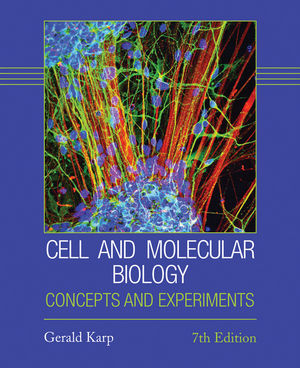Test Bank for Cell and Molecular Biology: Concepts and Experiments, 7th Edition, Gerald Karp
You are buying Test Bank. A Test Bank is collection of test questions tailored to the contents of an individual . Test bank may contains the following types of questions: multiple choice, true/false, fill in the blank, matching, essay/short answer, and free-response questions. Please download sample for your confidential.

Product details:
- ISBN-10 : 111830179X
- ISBN-13 : 978-1118301791
- Author: Binder Ready
The Seventh Edition of Cell and Molecular Biology: Concepts and Experiments, Binder Ready Version connects experimental material to key concepts of Cell Biology. The text offers streamlined information that reinforces a connection of key concepts to experimentation. Through the use of paired art and new science illustrations; readers benefit from a visual representation of experimental connections. Animations and video clips are tied to key illustrations with practice questions to provide a variety of ways to experience a key concept. The new 7th edition offers an appropriate balance of concepts and experimentation. Experimental detail is offered when it helps to reinforce the concept being explained. This text is an unbound, binder-ready version.
Table of Contents
1 Introduction to the Study of Cell and Molecular Biology 1
1.1 The Discovery of Cells 2
1.2 Basic Properties of Cells 3
Cells Are Highly Complex and Organized 3
Cells Possess a Generic Program and the Means to Use It 5
Cells Are Capable of Producing More of Themselves 5
Cells Acquire and Utilize Energy 5
Cells Carry Out a Variety of Chemical Reactions 6
Cells Engage in Mechanical Activities 6
Cells Are Able to Respond to Stimuli 6
Cells Are Capable of Self-Regulation 6
Cells Evolve 7
1.3 Two Fundamentally Different Classes of Cells 7
Characteristics That Distinguish Prokaryotic and Eukaryotic Cells 8
Types of Prokaryotic Cells 14
Types of Eukaryotic Cells: Cell Specialization 15
The Sizes of Cells and Their Components 17
Synthetic Biology 17
1.4 Viruses 23
Viroids 26
2 The Chemical Basis of Life 32
2.1 Covalent Bonds 33
Polar and Nonpolar Molecules 34
Ionizaton 34
2.2 Noncovalent Bonds 34
Ionic Bonds: Attractions between Charged Atoms 35
Hydrogen Bonds 36
Hydrophobic Interactions and van der Waals Forces 36
The Life-Supporting Properties of Water 37
2.3 Acids, Bases, and Buffers 39
2.4 The Nature of Biological Molecules 40
Functional Groups 41
A Classification of Biological Molecules by Function 41
2.5 Four Types of Biological Molecules 42
Carbohydrates 43
Lipids 47
Proteins 50
Nucleic Acids 77
2.6 The Formation of Complex Macromolecular Structures 79
The Assembly of Tobacco Mosaic Virus Particles and Ribosomal Subunits 79
3 Bioenergetics,Enzymes, and Metabolism 86
3.1 Bioenergetics 87
The Laws of Thermodynamics and the Concept of Entropy 87
Free Energy 89
3.2 Enzymes as Biological Catalysts 94
The Properties of Enzymes 95
Overcoming the Activation Energy Barrier 96
The Active Site 97
Mechanisms of Enzyme Catalysis 99
Enzyme Kinetics 102
3.3 Metabolism 108
An Overview of Metabolism 108
Oxidation and Reduction: A Matter of Electrons 109
The Capture and Utilization of Energy 110
Metabolic Regulation 115
4 The Structure and Function of the Plasma Membrane 120
4.1 An Overview of Membrane Functions 121
4.2 A Brief History of Studies on Plasma Membrane Structure 123
4.3 The Chemical Composition of Membranes 125
Membrane Lipids 125
The Asymmetry of Membrane Lipids 128
Membrane Carbohydrates 129
4.4 The Structure and Functions of Membrane Proteins 130
Integral Membrane Proteins 130
Studying the Structure and Properties of Integral Membrane Proteins 132Peripheral Membrane Proteins 137
Lipid-Anchored Membrane Proteins 137
4.5 Membrane Lipids and Membrane Fluidity 138
The Importance of Membrane Fluidity 139
Maintaining Membrane Fluidity 139
Lipid Rafts 139
4.6 The Dynamic Nature of the Plasma Membrane 140
The Diffusion of Membrane Proteins after Cell Fusion 141
Restrictions on Protein and Lipid Mobility 142
The Red Blood Cell: An Example of Plasma Membrane Structure 145
4.7 The Movement of Substances Across Cell Membranes 147
The Energetics of Solute Movement 147
Diffusion of Substances through Membranes 149
Facilitated Diffusion 156
Active Transport 157
4.8 Membrane Potentials and Nerve Impulses 164
The Resting Potential 164
The Action Potential 165
Propagation of Action Potentials as an Impulse 167
Neurotransmission: Jumping the Synaptic Cleft 168
5 Aerobic Respiration and the Mitochondrion 178
5.1 Mitochondrial Structure and Function 179
Mitochondrial Membranes 180
The Mitochondrial Matrix 182
5.2 Oxidative Metabolism in the Mitochondrion 183
The Tricarboxylic Acid (TCA) Cycle 185
The Importance of Reduced Coenzymes in the Formation of ATP 186
5.3 The Role of Mitochondria in the Formation of ATP 189
OxidationReduction Potentials 189
Electron Transport 190
Types of Electron Carriers 191
5.4 Translocation of Protons and the Establishment of a Proton-Motive Force 198
5.5 The Machinery for ATP Formation 199
The Structure of ATP Synthase 200
The Basis of ATP Formation According to the Binding Change Mechanism 201
Other Roles for the Proton-Motive Force in Addition to ATP Synthesis 205
5.6 Peroxisomes 206
6 Photosynthesis and the Chloroplast 211
6.1 Chloroplast Structure and Function 213
6.2 An Overview of Photosynthetic Metabolism 214
6.3 The Absorption of Light 216
Photosynthetic Pigments 216
6.4 Photosynthetic Units and Reaction Centers 218
Oxygen Formation: Coordinating the Action of Two Different Photosynthetic Systems 218
Killing Weeds by Inhibiting Electron Transport 225
6.5 Photophosphorylation 225
Noncyclic Versus Cyclic Photophosphorylation 226
6.6 Carbon Dioxide Fixation and the Synthesis of Carbohydrate 226
Carbohydrate Synthesis in C3 Plants 226
Carbohydrate Synthesis in C4 Plants 231
Carbohydrate Synthesis in CAM Plants 232
7 Interactions Between Cells and Their Environment 235
7.1 The Extracellular Space 236
The Extracellular Matrix 236
7.2 Interactions of Cells with Extracellular Materials 244
Integrins 244
Focal Adhesions and Hemidesmosomes: Anchoring Cells to Their Substratum 247
7.3 Interactions of Cells with Other Cells 250
Selectins 251
The Immunoglobulin Superfamily 252
Cadherins 253
Adhesion in Inflammation and Metastasis 255
Adherens Junctions and Desmosomes: Anchoring Cells to Other Cells 257
The Role of Cell-Adhesion Receptors in Transmembrane Signaling 259
7.4 Tight Junctions: Sealing The Extracellular Space 260
7.5 Gap Junctions and Plasmodesmata: Mediating Intercellular Communication 262
Plasmodesmata 265
7.6 Cell Walls 266
8 Cytoplasmic Membrane Systems: Structure, Function, and Membrane Trafficking 270
8.1 An Overview of the Endomembrane System 271
8.2 A Few Approaches to the Study of Endomembranes 273
Insights Gained from Autoradiography 273
Insights Gained from the Use of the Green Fluorescent Protein 273
Insights Gained from the Biochemical Analysis of Subcellular Fractions 275
Insights Gained from the Use of Cell-Free Systems 276
Insights Gained from the Study of Mutant Phenotypes 277
8.3 The Endoplasmic Reticulum 279
The Smooth Endoplasmic Reticulum 280
Functions of the Rough Endoplasmic Reticulum 280
From the ER to the Golgi Complex: The First Step in Vesicular Transport 289
8.4 The Golgi Complex 290
Glycosylation in the Golgi Complex 292
The Movement of Materials through the Golgi Complex 292
8.5 Types of Vesicle Transport and Their Functions 295
COPII-Coated Vesicles: Transporting Cargo from the ER to the Golgi Complex 296
COPI-Coated Vesicles: Transporting Escaped Proteins Back to the ER 298
Beyond the Golgi Complex: Sorting Proteins at the TGN 298
Targeting Vesicles to a Particular Compartment 300
8.6 Lysosomes 303
Autophagy 304
8.7 Plant Cell Vacuoles 307
8.8 The Endocytic Pathway: Moving Membrane and Materials into the Cell Interior 308
Endocytosis 308
Phagocytosis 315
8.9 Posttranslational Uptake of Proteins by Peroxisomes, Mitochondria, and Chloroplasts 316
Uptake of Proteins into Peroxisomes 316
Uptake of Proteins into Mitochondria 316
Uptake of Proteins into Chloroplasts 318
9 The Cytoskeleton and Cell Motility 324
9.1 Overview of the Major Functions of the Cytoskeleton 325
9.2 The Study of the Cytoskeleton 326
The Use of Live-Cell Fluorescence Imaging 326
The Use of In Vitro and In Vivo Single-Molecule Assays 327
The Use of Fluorescence Imaging Techniques to Monitor the Dynamics of the Cytoskeleton 329
9.3 Microtubules 330
Structure and Composition 330
Microtubule-Associated Proteins 331
Microtubules as Structural Supports and Organizers 332
Microtubules as Agents of Intracellular Motility 333
Motor Proteins that Traverse the Microtubular Cytoskeleton 334
Microtubule-Organizing Centers (MTOCs) 339
The Dynamic Properties of Microtubules 341
Cilia and Flagella: Structure and Function 345
9.4 Intermediate Filaments 354
Intermediate Filament Assembly and Disassembly 354
Types and Functions of Intermediate Filaments 356
9.5 Microfilaments 356
Microfilament Assembly and Disassembly 358
Myosin: The Molecular Motor of Actin Filaments 360
9.6 Muscle Contractility 364
The Sliding Filament Model of Muscle Contraction 366
9.7 Nonmuscle Motility 371
Actin-Binding Proteins 372
Examples of Nonmuscle Motility and Contractility 374
10 The Nature of the Gene and the Genome 386
10.1 The Concept of a Gene as a Unit of Inheritance 387
10.2 Chromosomes: The Physical Carriers of the Genes 388
The Discovery of Chromosomes 388
Chromosomes as the Carriers of Genetic Information 389
Genetic Analysis in Drosophila 390
Crossing Over and Recombination 390
Mutagenesis and Giant Chromosomes 392
10.3 The Chemical Nature of the Gene 393
The Structure of DNA 393
The Watson-Crick Proposal 394
DNA Supercoiling 397
10.4 The Structure of the Genome 398
The Complexity of the Genome 399
10.5 The Stability of the Genome 406
Whole-Genome Duplication (Polyploidization) 406
Duplication and Modification of DNA Sequences 407
Jumping Genes and the Dynamic Nature of the Genome 408
10.6 Sequencing Genomes: The Footprints of Biological Evolution 411
Comparative Genomics: If Its Conserved, It Must Be Important 413
The Genetic Basis of Being Human 414
Genetic Variation Within the Human Species Population 416
11 Gene Expression: From Transcription to Translation 426
11.1 The Relationship between Genes, Proteins, and RNAs 427
An Overview of the Flow of Information through the Cell 428
11.2 An Overview of Transcription in Both Prokaryotic and Eukaryotic Cells 429
Transcription in Bacteria 432
Transcription and RNA Processing in Eukaryotic Cells 433
11.3 Synthesis and Processing of Eukaryotic Ribosomal and Transfer RNAs 435
Synthesizing the rRNA Precursor 436
Processing the rRNA Precursor 437
Synthesis and Processing of the 5S rRNA 440
Transfer RNAs 440
11.4 Synthesis and Processing of Eukaryotic Messenger RNAs 441
The Machinery for mRNA Transcription 441
Split Genes: An Unexpected Finding 444
The Processing of Eukaryotic Messenger RNAs 448
Evolutionary Implications of Split Genes and RNA Splicing 454
Creating New Ribozymes in the Laboratory 454
11.5 Small Regulatory RNAs and RNA Silencing Pathways 455
MicroRNAs: Small RNAs that Regulate Gene Expression 459
piRNAs: A Class of Small RNAs that Function in Germ Cells 460
Other Noncoding RNAs 461
11.6 Encoding Genetic Information 461
The Properties of the Genetic Code 461
11.7 Decoding the Codons: The Role of Transfer RNAs 464
The Structure of tRNAs 465
11.8 Translating Genetic Information 468
Initiation 468
Elongation 471
Termination 474
mRNA Surveillance and Quality Control 474
Polyribosomes 475
12 Control of Gene Expression 483
12.1 Control of Gene Expression in Bacteria 484
Organization of Bacterial Genomes 484
The Bacterial Operon 484
Riboswitches 487
12.2 Control of Gene Expression in Eukaryotes: Structure and Function of the Cell Nucleus 488
The Nuclear Envelope 488
Chromosomes and Chromatin 493
Epigenetics: Theres More to Inheritance than DNA 509
The Nucleus as an Organized Organelle 510
12.3 An Overview of Gene Regulation in Eukaryotes 512
12.4 Transcriptional Control 514
The Role of Transcription Factors in Regulating Gene Expression 517
The Structure of Transcription Factors 519
DNA Sites Involved in Regulating Transcription 522
Transcriptional Activation: The Role of Enhancers, Promoters, and Coactivators 525
Transcriptional Repression 530
12.5 RNA Processing Control 533
12.6 Translational Control 536
Initiation of Translation 536
Cytoplasmic Localization of mRNAs 537
The Control of mRNA Stability 538
The Role of MicroRNAs in Translational Control 539
12.7 Posttranslational Control: Determining Protein Stability 541
13 DNA Replication and Repair 545
13.1 DNA Replication 546
Semiconservative Replication 546
Replication in Bacterial Cells 549
The Structure and Functions of DNA Polymerases 554
Replication in Eukaryotic Cells 558
13.2 DNA Repair 564
Nucleotide Excision Repair 565
Base Excision Repair 566
Mismatch Repair 567
Double-Strand Breakage Repair 567
13.3 Between Replication and Repair 568
14 Cellular Reproduction 572
14.1 The Cell Cycle 573
Cell Cycles in Vivo 574
Control of the Cell Cycle 574
14.2 M Phase: Mitosis and Cytokinesis 581
Prophase 583
Prometaphase 588
Metaphase 590
Anaphase 592
Telophase 597
Motor Proteins Required for Mitotic Movements 597
Cytokinesis 597
14.3 Meiosis 602
The Stages of Meiosis 603
Genetic Recombination During Meiosis 610
15 Cell Signaling and Signal Transduction: Communication Between Cells 617
15.1 The Basic Elements of Cell Signaling Systems 618
15.2 A Survey of Extracellular Messengers and Their Receptors 621
15.3 G Protein-Coupled Receptors and Their Second Messengers 621
Signal Transduction by G Protein-Coupled Receptors 622
Second Messengers 627
The Specificity of G Protein-Coupled Responses 630
Regulation of Blood Glucose Levels 631
The Role of GPCRs in Sensory Perception 634
15.4 Protein-Tyrosine Phosphorylation as a Mechanism for Signal Transduction 636
The Ras-MAP Kinase Pathway 640
Signaling by the Insulin Receptor 644
Signaling Pathways in Plants 648
15.5 The Role of Calcium as an Intracellular Messenger 648
Regulating Calcium Concentrations in Plant Cells 652
15.6 Convergence, Divergence, and Cross-Talk Among Different Signaling Pathways 653
Examples of Convergence, Divergence, and Cross-Talk Among Signaling Pathways 654
15.7 The Role of NO as an Intercellular Messenger 655
15.8 Apoptosis (Programmed Cell Death) 656
The Extrinsic Pathway of Apoptosis 658
The Intrinsic Pathway of Apoptosis 659
16 Cancer 664
16.1 Basic Properties of a Cancer Cell 665
16.2 The Causes of Cancer 667
16.3 The Genetics of Cancer 669
Tumor-Suppressor Genes and Oncogenes: Brakes and Accelerators 671
The Cancer Genome 683
Gene-Expression Analysis 685
16.4 New Strategies for Combating Cancer 687
Immunotherapy 688
Inhibiting the Activity of Cancer-Promoting Proteins 689
Inhibiting the Formation of New Blood Vessels (Angiogenesis) 692
17 The Immune Response 699
17.1 An Overview of the Immune Response 700
Innate Immune Responses 700
Adaptive Immune Responses 703
17.2 The Clonal Selection Theory as It Applies to B Cells 704
Vaccination 706
17.3 T Lymphocytes: Activation and Mechanism of Action 707
17.4 Selected Topics on the Cellular and Molecular Basis of Immunity 710
The Modular Structure of Antibodies 710
DNA Rearrangements that Produce Genes Encoding B- and T-Cell Antigen Receptors 713
Membrane-Bound Antigen Receptor Complexes 716
The Major Histocompatibility Complex 716
Distinguishing Self from Nonself 721
Lymphocytes Are Activated by Cell-Surface Signals 722
Signal Transduction Pathways in Lymphocyte Activation 723
18 Techniques in Cell and Molecular Biology 732
18.1 The Light Microscope 733
Resolution 733
Visibility 734
Preparation of Specimens for Bright-Field Light Microscopy 735
Phase-Contrast Microscopy 735
Fluorescence Microscopy (and Related Fluorescence-Based Techniques) 736
Video Microscopy and Image Processing 738
Laser Scanning Confocal Microscopy 739
Super-Resolution Fluorescence Microscopy 740
18.2 Transmission Electron Microscopy 740
Specimen Preparation for Electron Microscopy 742
18.3 Scanning Electron and Atomic Force Microscopy 746
Atomic Force Microscopy 748
18.4 The Use of Radioisotopes 748
18.5 Cell Culture 749
18.6 The Fractionation of a Cells Contents by Differential Centrifugation 752
18.7 Isolation, Purification, and Fractionation of Proteins 752
Selective Precipitation 752
Liquid Column Chromatography 753
Polyacrylamide Gel Electrophoresis 756
Protein Measurement and Analysis 757
18.8 Determining the Structure of Proteins and Multisubunit Complexes 758
18.9 Fractionation of Nucleic Acids 760
Separation of DNAs by Gel Electrophoresis 760
Separation of Nucleic Acids by Ultracentrifugation 760
18.10 Nucleic Acid Hybridization 762
18.11 Chemical Synthesis of DNA 764
18.12 Recombinant DNA Technology 764
Restriction Endonucleases 764
Formation of Recombinant DNAs 766
DNA Cloning 766
18.13 Enzymatic Amplification of DNA by PCR 769
Applications of PCR 770
18.14 DNA Sequencing 771
18.15 DNA Libraries 773
Genomic Libraries 773
cDNA Libraries 774
18.16 DNA Transfer into Eukaryotic Cells and Mammalian Embryos 775
18.17 Determining Eukaryotic Gene Function by Gene Elimination or Silencing 778
In Vitro Mutagenesis 778
Knockout Mice 778
RNA Interference 780
18.18 The Use of Antibodies 780
Glossary G-1
Additional Readings A-1
Index I-1
People also search:
cell and molecular biology 7th edition
cell and molecular biology 7th edition price
cell and molecular biology karp 7th edition
what is cell and molecular biology
is cell and molecular biology hard





